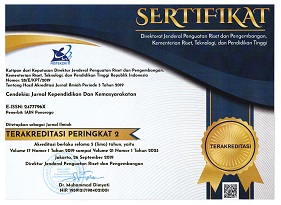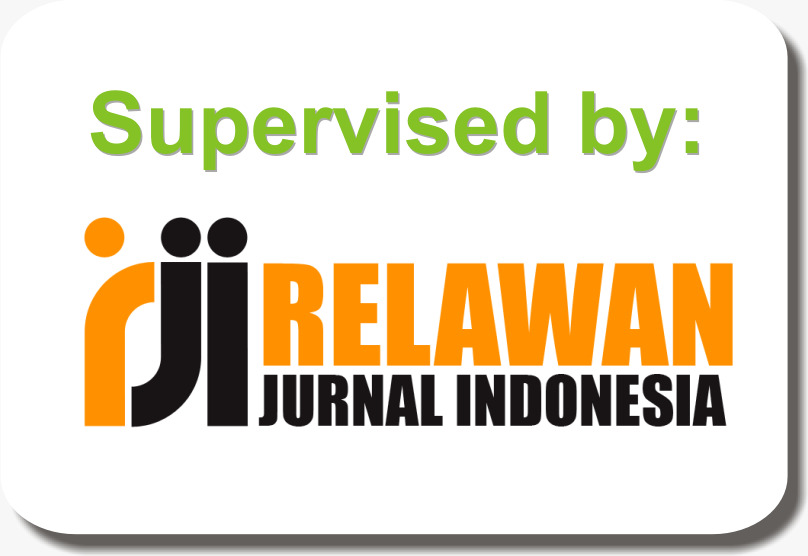Development of Augmented Reality in Islamic Religious Education as an Anti-Corruption Learning Medium
DOI:
https://doi.org/10.21154/cendekia.v20i2.3817Keywords:
anti-corruption knowledge, augmented reality, junior high schoolAbstract
This study aims to develop and determine the impact of using augmented reality as an anti-corruption educational medium based on the development of Islamic educational materials. The data processing used to research and development methods ADDIE model using a validity test and measurements of N-Gain scores. Three junior high schools with different environmental characteristics participated in the study. The findings first indicate that the development of augmented reality for the field of anti-corruption education can be adapted to the essential competencies of Islamic Religious Education subjects with the themes of honesty, trustworthiness, and istiqomah. Second, there was an increase in the cognitive domain, as indicated by the anti-corruption education values for SMP N 02 Bawang students by 79.5%; SMP N 01 Subah students by 79%; and SMP N 01 Batang students by 80.44%. On the N-Gain scale, all three achievements are considered effective. This research has implications for demonstrating that the application of augmented reality can effectively improve cognitive ability in anti-corruption education based on the development of Islamic educational materials. We recommend that these findings be used as a basis for determining anti-corruption education policies in Indonesia
References
Akçayir, M., and Akçayir, G. “Advantages and Challenges Associated with AR for Education: A Systematic Review of Theliterature.” Educ. Res. Rev. 20, no. 1 (2016).
Arifin, Syamsul. “Islamic Religious Education and Radicalism in Indonesia: Strategy of de-Radicalization through Strengthening the Living Values Education.” Indonesian Journal of Islam and Muslim Societies 6, no. 1 (2016): 93”“126.
Asrori, Ahmad. “RADIKALISME DI INDONESIA: Antara Historisitas Dan Antropisitas.” KALAM (2017).
Bacca, J., Baldiris, S., Fabregat, R., Graf, S., and Kinshuk. “AR Trends in Education: A Systematic Review of Research and Applications.” Educ. Technol. Soc. 17, no. 2 (2014): 133.
Bernard. Research Methods in Anthropology: Qualitative and Quantitative Methods. Altamira: Walnut Creek, 2002.
Branch, Robert Maribe. “Instructional Design: The ADDIE Approach.” Springer Science & Business Media 722. (2009).
Chen, C. H., Lee, I. J., and Lin, L. Y. “AR-Based Self-Facial Modeling to Promote the Emotional Expression and Social Skills of Adolescents with Autism Spectrum Disorders.” Res. Dev. Disabil. 36C 36, no. 1 (2015): 396”“403.
Chua, Y. T. “Robbed: An Investigation of Corruption in Philippine Education".” Philippines, Center for Investigative Journalism. (1999).
Diegmann, P., Schmidt-Kraepelin, M., Eynden, S., and Basten, D. “”˜Benefits of AR in Educational Environments”“A Systematic Literature Review.’” Wirtschaftsinformatik (2015).
Edi Subkhan. “Pendidikan Antikorupsi Perspektif Pedagogi Kritis,.” Journal Abdimas Volume 6, no. 1 (2014): 15”“30.
Erna, Erna. “Implementasi Augmanted Reality Sebagai Media Pengenalan Sains Sederhana Pada Anak Usia Dini.” Jurnal RESTI (Rekayasa Sistem dan Teknologi Informasi) 2, no. 1 (2018).
H., Eko. “Pendidikan Anti Korupsi Dalam Membentuk Generasi Muda Yang Jujur Dan Berintegritas Di SMA Semesta Kota Semarang Authors.” Journal Abdimas 18 (2014).
Ibáñez, M., and Delgado-kloos, C. AR for STEM Learning: A Systematic Review. Comput. Educ., 2018.
Ioannou, A., and Constantinou, V. “AR Supporting Deaf Students in Mainstream Schools: Two Case Studies of Practical Utility of the Technology. Hamilton.” Springer International Publishing (2018).
Jacob, B. and Levitt D. “”˜Rotten Apples: An Investigation of the Prevalence and Predictors of Teacher Cheating.’” Quarterly Journals of Economics 118, no. 3 (2013): ,843-877.
Junaedi, Mahfud. “"Strategies For Delivering Islamic Religious Education Learning Materials in The Post-Truth Era.” " NUANSA: Jurnal Penelitian Ilmu Sosial dan Keagamaan Islam 19, no. 2 (2022): 127”“145.
MartÃnez, J. “”˜Corrupción de Estado En CONALITEG. Vamos México: El Peón de La Reina.’” Benemérita Universidad Autónoma de Puebla, Puebla, Mexico. (n.d.).
Marzuki, Miftahuddin, and Mukhamad Murdiono. “Multicultural Education in Salaf Pesantren and Prevention of Religious Radicalism in Indonesia.” Cakrawala Pendidikan 39, no. 1 (2020): 12”“25.
Mirzaei, M. R., Ghorshi, S., Mortazavi, M., Mirzaei, M. R., Ghorshi, S., Mortazavi, M, et al. “”˜Audio-Visual Speech Recognition Techniques in AR Environments. Vis. Comput.’” 30, no. 2 (2019): 245”“257.
MUNADI, Muhammad. “PERAN PENDIDIK PAI DALAM PENGEMBANGAN PEMBELAJARAN AGAMA YANG INKLUSIF DI SEKOLAH.” Cendekia: Jurnal Kependidikan dan Kemasyarakatan, [S.l.], v. (2012).
Nasikhin, Shodiq, Nasikhin, Ulul Albab, Baiti Al-Ami, and Ismutik. “Tantangan Pendidikan Agama Islam Di Era Posh Truth.” Al Manam 2, no. 1 (2022): 25”“36.
Nela Suryaningtyas , Siswandari, dan Nurhasan Hamidi. “Persepsi Siswa Tentang Nilai Kemandirian Pada Pendidikan Antikorupsi (Studi Di SMK).” Jurnal “Tata Arta” UNS, Vol. 5, no. No. 1, April, 2019 (2019): hlm 82-94.
Nurdyansyah. N., Andiek Widodo. Inovasi Teknologi Pembelajaran. Sidoarjo: Nizamia Learning Center, 2015.
Phon, D. N., Ali, M. B., and Halim, N. D. “”˜Collaborative AR in Education: A Review.’” In International Conference on Teaching and Learning in Computing and Engineering, 2014.
Puspito, N. T., Elwina-S, M., Utari, I. S., & Kurniadi, Y. “Pendidikan Anti Korpusi Untuk Perguruan Tinggi.” Kementerian Pendidikan dan Kebudayaan. Jakarta, 2011. (n.d.).
Reinikka, R and Svensson, J. Fighting Corruption to Improve Schooling: Evidence from a Newspaper Campaign in Uganda", Working Pa (2004).
Rusydi Ananda dan Muhammad Fadhli. Statistik Pendidikan Teori Dan Praktik Dalam Pendidikan. Medan: CV. Widya Puspita, 2018.
Sakinah, N., & Bakhtiar, N. “Model Pendidikan Anti Korupsi Di Sekolah Dasar Dalam Mewujudkan Generasi Yang Bersih Dan Berintegritas Sejak Dini.” Journal of Primary Education 3, no. 2 (2019): 89”“112.
Santos, M. E. C., Lübke, A. I. W., Taketomi, T., Yamamoto, G., Rodrigo, M. M. T., et al. “AR as Multimedia: The Case for Situated Vocabulary Learning.” Res. Pract. Technol. Enhanced Learn (2019).
TAFQIHAN, Zuhdi. “KARAKTERISTIK DAN PEMILIHAN MEDIA PEMBELAJARAN DALAM E-LEARNING.” Cendekia: Jurnal Kependidikan dan Kemasyarakatan, 09 (2019): 141”“154.
Downloads
Published
Issue
Section
License
Copyright & License
Please find the rights and licenses in Cendekia: Jurnal Kependidikan dan Kemasyarakatan. By submitting the article/manuscript, the author(s) agree with this policy. No specific document sign-off is required.
1. License
The non-commercial use of the article will be governed by the Creative Commons Attribution license as currently displayed on the Creative Commons Attribution-NonCommercial 4.0 International License.
2. Author(s)' Warranties
The author warrants that the article is original, written by the stated author(s), has not been published before, contains no unlawful statements, does not infringe the rights of others, is subject to copyright that is vested exclusively in the author and free of any third party rights, and that any necessary written permissions to quote from other sources have been obtained by the author(s).
3. User/Public Rights
The spirit of Cendekia: Jurnal Kependidikan dan Kemasyarakatan is to disseminate articles published as free as possible. Under the Creative Commons license, Cendekia: Jurnal Kependidikan dan Kemasyarakatan permits users to copy, distribute, display, and perform the work for non-commercial purposes. Users will also need to attribute authors and Cendekia: Jurnal Kependidikan dan Kemasyarakatan on distributing works in the journal and other media of publications. Unless otherwise stated, the authors are public entities as soon as their articles got published.
4. Rights of Authors
Authors retain all their rights to the published works, such as (but not limited to) the following rights;
- Copyright and other proprietary rights relating to the article, such as patent rights,
- The right to use the substance of the article in own future works, including lectures and books,
- The right to reproduce the article for own purposes,
- The right to self-archive the article,
- The right to enter into separate, additional contractual arrangements for the non-exclusive distribution of the article's published version (e.g., post it to an institutional repository or publish it in a book), with an acknowledgment of its initial publication in this journal (Cendekia: Jurnal Kependidikan dan Kemasyarakatan).
5. Co-Authorship
If the article was jointly prepared by more than one author, any author submitting the manuscript warrants that he/she has been authorized by all co-authors to be agreed on this copyright and license notice (agreement) on their behalf and agrees to inform his/her co-authors of the terms of this policy. Cendekia: Jurnal Kependidikan dan Kemasyarakatan will not be held liable for anything arising due to the author(s) internal dispute. Cendekia: Jurnal Kependidikan dan Kemasyarakatan will only communicate with the corresponding author.
6. Royalties
Being an open accessed journal and disseminating articles for free under the Creative Commons license term mentioned, the author(s) are aware that Cendekia: Jurnal Kependidikan dan Kemasyarakatan entitles the author(s) to no royalties or other fees.
7. Miscellaneous
Cendekia: Jurnal Kependidikan dan Kemasyarakatan will publish the article (or have it published) in the journal if the article's editorial process is completed. The editors of Cendekia: Jurnal Kependidikan dan Kemasyarakatan may modify the paper to a style of punctuation, spelling, capitalization, referencing, and usage that deems appropriate. The author acknowledges that the article may be published so that it will be publicly accessible, and such access will be free of charge for the readers, as mentioned in point 3.

















